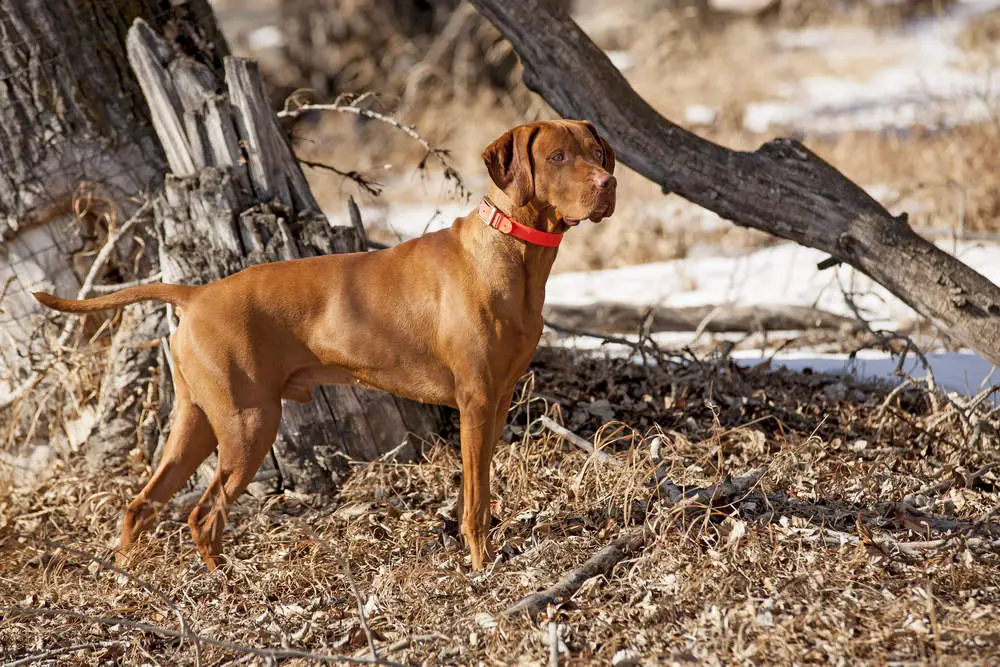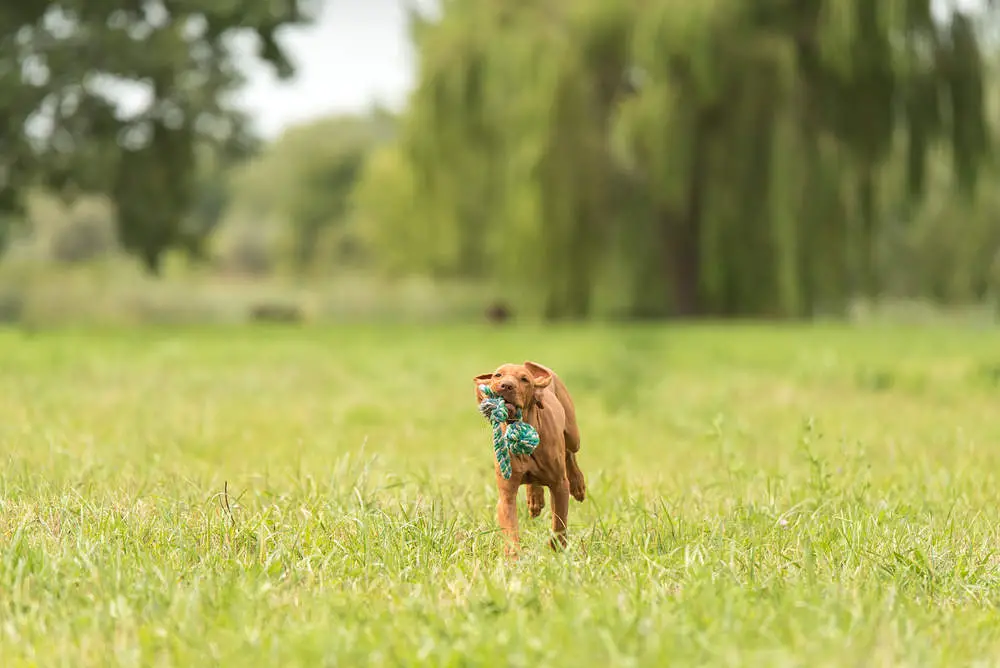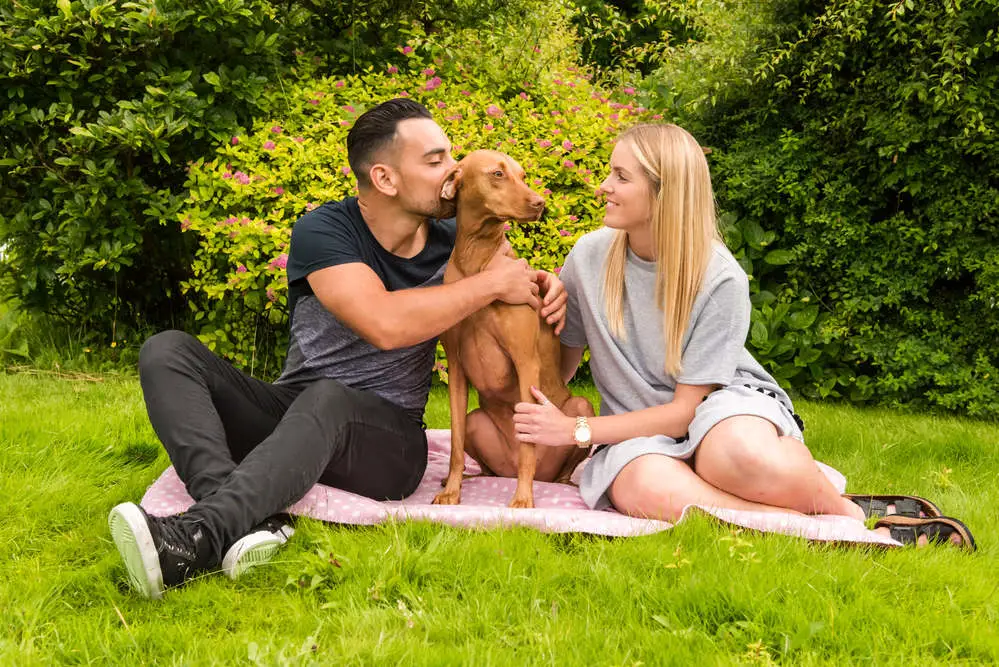
There are toy dogs, lap dogs, arm candy dogs and many more varieties. Vizslas are none of those.
These are highly-energetic dogs with a history of being hunting partners. If you want to get one of these, you need to be prepared.
So, here we go.
Vizsla Dog Breed Profile at a Glance
- Height: 22 to 24 inches (males); 12 to 23 inches (females)
- Weight: 45 to 60 pounds (males); 40 to 55 pounds (females)
- Appearance: Medium-sized, short coat in different shades of golden rust
- Temperament: Intelligent, obedient, gentle, affectionate and energetic
- Lifespan: 12 to 15 years
The Origin Story
The Vizsla dogs were originally from Hungary and can be found in drawings as far back as the 10th century. They have a noble heritage and were used as hunting dogs by the Magyar clan.
The Hungarian Vizslas have superior noses, courage, great stamina and speed, all of which are much-coveted traits for a hunting dog. They could work on different terrains like forests, fields and water and were almost extinct after the World Wars because they were seen as a symbol of the aristocracy.
Related: 7 Main Vizsla Colors: Everything You Need To Know
But some of them were smuggled into other countries for their own protection. That is how they reached America in the 1950s and were recognized by the American Kennel Club a decade later.
While the population declined in the 19th century, today, they are back to being a popular choice by breeders and pet owners in North America and Europe.
Related: Vizsla vs Weimaraner: What’s the Difference?
Temperament and Behavior
These are highly energetic dogs that make for great hunting and hiking partners. Vizslas have a powerful nose which means they are always following interesting scents.
This is a breed of intelligent and obedient dogs that can get agitated and even destructive if they don’t get enough exercise. They are stubborn and sometimes timid by nature but that can be taken care of if they are given the right training early on.
These are also protective and sensitive dogs that like to spend time with their dog parent and respond well to positive reinforcement. You might want to supervise them if you have small animals like rabbits, cats and guinea pigs as pets in the house.
Related: Can a Vizsla Be a Service Dog?
It is also a good idea to keep an eye on them when these small animals are around in the outdoors as Vizslas tend to view them as prey. With the right amount of training, they are good with children.
While they are independent, they can suffer from separation anxiety if you leave them alone or in a kennel for too long. This can also lead to destructive behavior and withdrawal.
So it is no surprise that they are called Velcro dogs.
Related: Do Vizslas Bark?
How to Care for a Vizsla

This is a pretty special dog and requires a certain kind of care. Let’s go over that in detail here.
Health Issues
These are usually a healthy breed of dogs that live for 12 to 15 years. But cancer is a concern as is the case with all purebreds and Vizsla mixed breeds.
Breeders who are responsible usually screen the dogs to understand the allergies, disorders like entropion or melanosis and diseases like ear infections, hip dysplasia and epilepsy. This is the best way of producing healthy pups.
The National Breed Club recommends that you get their hips and thyroid evaluated along with scheduling an ophthalmologist evaluation. Some Vizslas are predisposed to these conditions genetically.
If you are getting your pet from a breeder, a health check on the parents will also give you an estimate of what to expect so that you can reduce the risk.
Also Read: 8 of the Best Dog Beds for Vizslas
These dogs are known to get epileptic seizures more often than the average dog. While there is no cure at the moment and research is still underway, with medication and lifestyle changes it can be managed.
These dogs are also prone to some auto-immune diseases. You might also experience some food and seasonal allergies.
Also Read: Where Should a Vizsla Sleep?
There is a condition called Vizsla inflammatory polymyopathy which is specific to this breed. In this situation, these dogs can experience muscle wastage near the skull, excessive drooling and trouble swallowing.
If it is detected in the early stages, immunosuppressant drugs can be used to treat it.
Hip dysplasia is also a common health issue in Vizslas. It is a progressive condition that occurs due to the abnormal formation of the hip joints and surgery can help in severe cases.
Related: What Health Problems Do Vizslas Have?
The Right Kind of Nutrition
Firstly, not all dogs eat alike. Even those that belong to the same breed.
So, since these are energetic dogs, you want to give them high-quality dog food. That gives them more nutrition and takes the focus away from quantity.
You can choose between the commercial varieties or give them homemade meals after consulting your vet and getting their approval. Make sure the diet is appropriate to your dog’s age because they all have different caloric needs.
Vizslas tend to eat well starting at a young age when the active Vizsla needs four to five cups of high-calorie food every day. Senior and less active dogs, however, need about half of that.
You want to be careful about how much food you give them because some of these dogs are prone to obesity. You must also take the treats given to them during training into account because that can also lead to overweight issues.
Also Read: Is My Vizsla Too Skinny?
Also, find out which human foods are okay with your dog. You can do that by consulting your vet when you discuss your dog’s weight and dietary requirements.
Measure their food and make sure they are fed twice a day. And never leave your dog without clean, fresh drinking water.
Let them finish their bowl while making sure that they are getting enough to eat and are staying in good shape. If you want to be certain that your dog is not overweight, do a simple hands-on test and an eye test.
Look down at them and see if you can spot the waist. Then put your hands on their back such that your thumbs are on their spine and the fingers are downwards.
See if you can feel their ribs without pressing your fingers hard. If you don’t feel the ribs, they need more exercise and if you are able to see the ribs, they need more food.
Related: How Much Do Vizslas Cost?
Training Notes
These dogs respond well to positive reinforcement. That’s an important thing to remember during the training sessions.
You must start early when they are still a puppy and make sure the training is consistent. These are very curious and intelligent dogs that are capable of subtle manipulation.
So, make sure you have a solid line of communication with them and are able to teach them how to behave right away. If your dog is untrained, it can be difficult to live with them.
They can also get agitated and unnecessarily creative if they are not engaged with activities for a long time. But they love to be trained and like all the attention they get during the session which is a great advantage for dog parents.
Do remember that these are sensitive dogs and must be socialized early on so that they grow into confident adults. Socialization also ensures that they get along with the other pets or children in the house.
You can do many field activities with Vizslas while training them. Some examples like hunting tests, obedience tests, agility and tracking tests come to mind.
They must also be tested for barn hunts, dock diving and scent work if possible. Since they are hunting dogs, discovering these skills can be a great asset.
As is the case with almost all dogs, do not be harsh to Vizslas while training them. Praising them and rewarding them with food and play are some of the best motivators.
When dealing with a puppy, a few minutes of training multiple times every day will yield good results. You will notice that they are really eager to please and will learn and follow instructions pretty quickly as long as you keep it positive.
Related: Do Vizslas Like to Swim?
Workout Regime
As mentioned before, these are hunting dogs that have an enormous appetite for exercise—physical and mental. While every dog has its own requirements, dog owners should put aside at least 30-60 minutes for a Vizsla’s exercise routine.
In some cases, your dog might need more than that. And we’re talking active exercising for 30 minutes or more.
Walks on a leash and playing fetch are a part of the routine but you must also plan games without a leash like Frisbee where they can run wild. You must also plan some activities that exercise their mind and keep them sharp regularly.
If you are a runner or a jogger yourself, this is a great companion dog to take along. Just remember that they must be 18 to 24 months old before you take them for long runs.
Related: How Fast Can Vizslas Run?
These dogs are meant to live in an active home with inhabitants who have an outdoorsy lifestyle. Vizslas are also excellent chewers so you want to give them toys to do that.
Otherwise, your furniture might fall prey to their teeth.
You might also think about competitive sports for Vizslas that encourage their agility, pointing and retrieving skills. They also love water so it’s no trouble doing this near a small water body.
Related: Do Vizslas Like to Dig?
Grooming Needs
Vizslas have a short and sleek coat and do not need too much maintenance. They do not have an undercoat but you must brush their coat with a rubber brush daily or regularly to keep track of their shedding.
And about bathing, make sure it is done with lukewarm water when needed like when they are dirty. Use a good-quality dog shampoo or a dry shampoo for the job.
Rinse their body thoroughly till you get rid of any bad odors.
Since there is a risk of them getting frustrated, you want to keep their nails trimmed and short. You can use a clipper or a grinding tool for the same.
This also keeps them from hurting themselves or anyone around them when they are outdoors. Check their ears regularly for wax or dirt and also their teeth to see if their gums are healthy.
You want to get into a regular cleaning routine for them and use dog toothpaste. While you’re at it, see if there is any change in their eyes because they are prone to those problems.
Related: When Do Vizslas Go Gray?
Still Can’t Decide?

There are a lot of good things and some to be cautious about. So we understand that it can be a tough choice.
To make it easy for you, we are going to break it down into the simplest terms. Let’s do pros and cons.
Pros
- These are extremely intelligent dogs.
- They are quick learners and people pleasers which makes them very easy to train.
- They have very low drooling tendencies.
- Grooming them is not a task at all since they don’t shed all that much.
- Their potential to gain weight is low to average which makes maintenance easy.
- When trained well, these dogs are friendly with other pets and children.
- Changes in lifestyle and living conditions are not a problem as they are very adaptable.
- They make for a good therapy dog.
- They are recommended as companions for senior citizens too.
- Vizslas like being on boats.
Cons
- They are not good with those who suffer from allergies.
- Vizslas need space which makes them a bit unfit to live in studio apartments.
- These dogs are very curious and like to explore their surroundings and are difficult to stop wandering.
- They suffer from separation anxiety when left alone or in a kennel for a long time.
- The tendency to chew or play-bite is higher than average.
- This is not the dog you want to take to your office.
- First-time dog owners might not want to take a chance. There are other dogs for you.
Final Thoughts
Vizslas are an extremely fascinating breed of dogs. They were meant to come with us to the wild and help us hunt but today, Vizslas are a wonderful pet for families with kids too.
These dogs have a seemingly endless amount of energy and will go as far as they can to make you happy. They are independent yet seek your approval.
Vizslas are a delight if you are outdoorsy and treat them like a member of your family…as you should.
